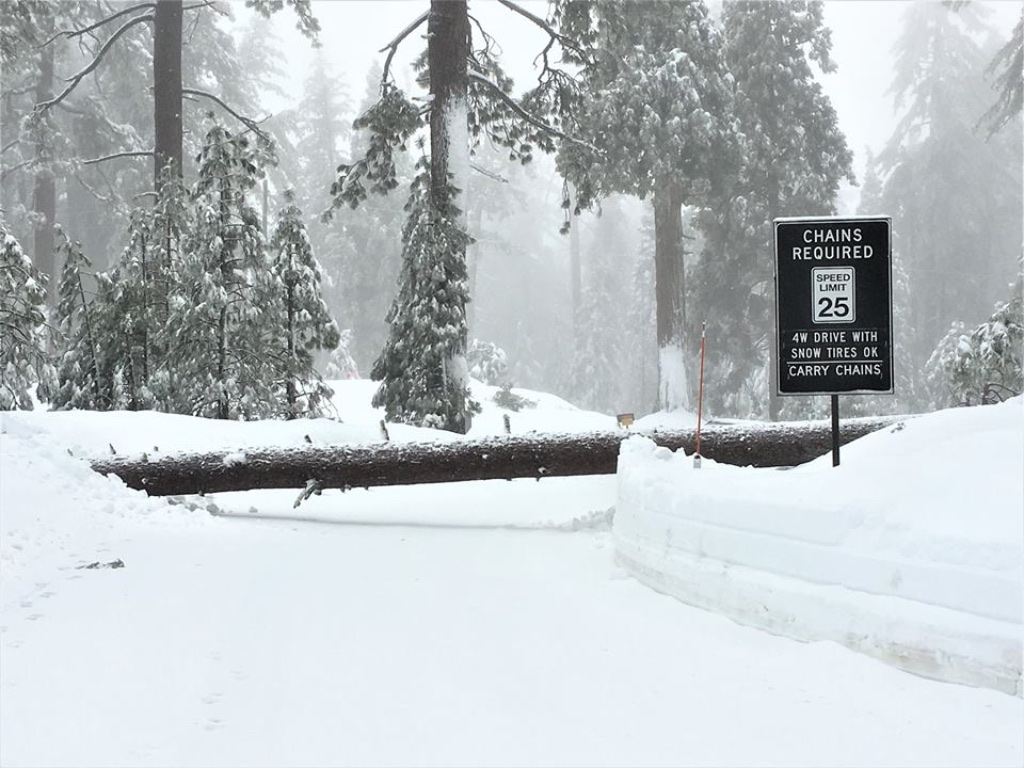The New Sequoia Forests of California by John Muir

The main forest belt of the Sierra Nevada is restricted to the western flank, and extends unbrokenly from one extremity of the range to the other, waving compliantly over countless ridges and cañons at an elevation of from three to eight thousand feet above the level of the sea.
Here grow the noblest conifers in the world, averaging about two hundred feet in height, and from five to twenty feet in diameter‚—the majestic Douglass spruce; the libocedrus, with warm yellow-green, plumelike foliage; the two silver-firs (Picea amabilis and P. grandis), towering to a height of more than two hundred feet, with branches pinnated like ferns, and whorled around, the trunk in regular collars, like the leaves of lilies; the yellow pine, forming arrowy spires of verdure; and the priestly sugar-pine, with feathery arms outspread as if addressing the forest. But the great master-existence of these unrivalled woods is Sequoia gigantea, or “big tree”‚—a monarch of monarchs.
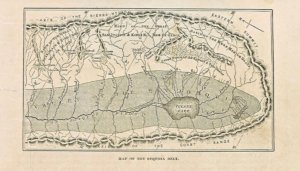
By reference to the map on page 815 it will be seen that the sequoia belt extends from the well-known Calaveras groves on the north to the head of Deer Creek on the south‚—a distance of nearly two hundred miles; the northern limit being a little above the thirty-eighth parallel, the southern a little below the thirty-sixth, and the elevation above sea-level varies from about five to eight thousand feet.
From the Calaveras to the south fork of King’s River the sequoia occurs only in small isolated groves and patches, so sparsely distributed along the belt that two gaps occur nearly forty miles in width, one between the Calaveras and Tuolumne groves, the other between those of the Fresno and King’s River. But from here southward nearly to Deer Creek the trees are nowhere gathered together into small sequestered groups, but stretch majestically across the broad rugged basins of the Kaweah and Tule in noble forests a distance of nearly seventy miles, the continuity of this magnificent belt being broken only by deep sheer-walled cañons.
The trees in most of the small northern groups have been counted. Those of the Calaveras number twelve or thirteen hundred; in the Tuolumne and Merced groups there is less than one hundred; in the well-known Mariposa grove, about six hundred; and in the North King’s River grove, less than half as many; but the Fresno group, the largest congregation of the north, occupies an area of three or four square miles.
The average stature attained by the Big Tree under favorable conditions is perhaps about 275 feet, with a diameter of twenty feet. Few full-grown specimens fall much short of this, while many are twenty-five feet in diameter and nearly 300 feet high. Fortunate trees, so situated as to have escaped the destructive action of fire, are occasionally found measuring thirty feet in diameter, and very rarely one that is much larger.

Yet so exquisitely harmonious are even the very mightiest of these monarchs in all their proportions and circumstances, there never is any tiling overgrown or huge-looking about them, not to say monstrous; and the first exclamation on coming upon a group for the first time is usually, “See what beautiful trees!”
Their real godlike grandeur in the mean time is invisible, but to the loving eye it will be manifested sooner or later, stealing slowly on the senses like the grandeur of Niagara, or of some lofty Yosemite dome. Even the mere arithmetical greatness is never guessed by the inexperienced as long as the tree is comprehended from a little distance in one harmonious view. When, however, we approach so near that only the lower portion of the trunk is seen, and walk round and round the wide bulging base, then we begin to wonder at their vastness, and seek a measuring rod.
Sequoias bulge considerably at the base, yet not more than is required for beauty and safety; and the only reason that this bulging is so often remarked as excessive is because so small a section of the shaft is seen at once. The real taper of the trunk, beheld as a unit, is perfectly charming in its exquisite fineness, and the appreciative eye ranges the massive columns, from the swelling muscular instep to the lofty summit dissolving in a crown of verdure, rejoicing in the unrivalled display of giant grandeur and giant loveliness.
About a hundred feet or more of the trunk is usually branchless, but its massive simplicity is relieved by the fluting bark furrows, and loose tufts and rosettes of slender sprays that wave lightly on the breeze and cast flecks of shade, seeming to have been pinned on here and there for the sake of beauty alone.
The young trees wear slender, simple branches all the way down to the ground, put on with strict regularity, sharply aspiring at top, horizontal about half-way down, and drooping in handsome curves at the base. By the time the sapling is five or six hundred years old, this spiry, feathery, juvenile habit merges into the firm rounded dome form of middle age, which in turn takes on the eccentric picturesqueness of old age. No other tree in the Sierra forests has foliage so densely massed, or presents outlines so firmly drawn and so constantly subordinate to a special type. A knotty, angular, ungovernable-looking branch eight or ten feet thick may often be seen pushing out abruptly from the trunk, as if sure to throw the outline curves into confusion, but as soon as the general outline is approached it stops short, and dissolves in spreading, cushiony bosses of law-abiding sprays, just as if every tree were growing underneath some huge invisible bell-glass, against whose curves every branch is pressed and moulded, yet somehow indulging so many small departures that there is still an appearance of perfect freedom.
The foliage of the saplings is dark bluish-green in color, while the older trees frequently ripen to a warm yellow tint like the libocedrus. The bark is rich cinnamon brown, purplish in younger trees, and in shady portions of the old, while all the ground is covered with brown burs and leaves, forming color masses of extraordinary richness, not to mention the flowers and underbrush that brighten and bloom in their season.
Walk the sequoia woods at any time of year, and you will say they are the most beautiful on earth. Rare and impressive contrasts meet you everywhere‚—the colors of tree and flower, rock and sky, light and shade, strength and frailty, endurance and evanescence. Tangles of supple hazel bushes, tree pillars rigid as granite domes, roses and violets around the very feet of the giants, and rugs of the low blooming chamaebatia where the light foils free. Then in winter the trees themselves break forth in universal bloom, myriads of small four-sided conelets crowd the ends of the slender sprays, coloring the whole tree, and, when ripe, dusting all the air and the ground with golden pollen. The fertile cones are bright grass green, measuring about two inches in length by one and a half in thickness, and are made up of about forty firm rhomboidal scales densely packed, with from five to eight seeds at the base of each. A single cone, therefore, contains from two to three hundred seeds, about a fourth of an inch long by three-sixteenths wide, including a thin flat margin that makes them go glancing and wavering in their fall like a boy’s kite. The irrepressible fruitfulness of sequoia may be illustrated by the fact that upon two specimen branches one and a half and two inches in diameter respectively I counted 480 cones clustered together like grapes. No other California conifer produces nearly so many seeds. Millions are ripened annually by a single tree, and the product of one of the small northern groves in a fruitful year would suffice to plant all the mountain ranges of the globe.
Nature takes care, however, that not one seed in a million shall germinate at all, and of those that do perhaps not one in ten thousand is suffered to live through the many vicissitudes of storm, drought, fire, and snow-crushing that beset their youth.
The Douglass squirrel, the “chickaree” of the West, is the happy harvester of most of the sequoia cones. Out of every hundred perhaps ninety-nine fall to his share, and unless cut off by his sharp ivory sickle, they shake out their seeds and remain firmly attached to the tree for many years. Watching the squirrels in their Indian-summer harvest days is one of the most delightful diversions imaginable. The woods are calm then, and the ripe colors are blazing in all their glory. The cone-laden trees poise motionless in the warm smoky air, and you may see the crimson-crested woodcock, the prince of Sierra woodpeckers, drilling the giant trees with his ivory pick, and ever and anon filling the glens with his careless cackle; the humming-bird, too, glancing among the pentstemons, or resting wing-weary on some leafless twig; and the old familiar robin of the orchards; and the great, grizzly or brown bear, so obviously fitted for these majestic solitudes‚—mammoth brown bears harmonizing grandly with mammoth brown trees. But the Douglass squirrel gives forth more appreciable life than all the birds, bears, and humming insects taken together. His movements are perfect jets and flashes of energy, as if surcharged with the refined fire and spice of the woods in which he feeds. He cuts off his food cones with one or two snips of his keen chisel teeth, and without waiting to see what becomes of them, cuts off another and another, keeping up a dripping, bumping shower for hours together. Then, after three or four bushels are thus harvested, he comes down to gather them, carrying them away patiently one by one in his month, with jaws grotesquely stretched, storing them in hollows beneath logs or under the roots of standing trees, in many different places, so that when his many granaries are full, his bread is indeed sure. Some demand has sprung up for sequoia seeds in foreign and American markets, and several thousand dollars’ worth is annually collected, most of which is stolen from the squirrels.
Sequoia gigantea has hitherto been regarded as a lonely, companionless species not properly belonging to the present geological age, and therefore doomed to speedy extinction. The scattered groves are supposed generally to be the remnants of extensive ancient forests, vanquished, in the so-called struggle for life, by pines and firs, and now driven into their last fortresses of cool glens, where moisture and general climate are specially favorable. These notions are grounded on the aspects and circumstances of the few isolated northern groups, the only ones known to botanists, where there are but few young trees or saplings growing up around the failing old ones to perpetuate the race.
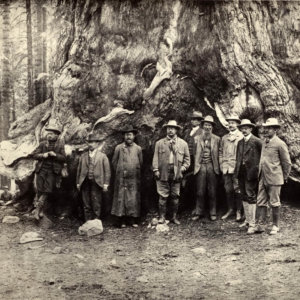
The most notable tree in the well-known Mariposa Grove is the Grizzly Giant, some thirty feet in diameter, growing on the top of a stony ridge. When this tree falls, it will make so extensive a basin by the up-tearing of its huge roots, and so deep and broad a ditch by the blow of its ponderous trunk, that even supposing that the trunk itself be speedily burned, traces of its existence will nevertheless remain patent for thousands of years. Because, being on a ridge, the root hollow and trunk ditch made by its fall will not be filled up by rain-washing, neither will they be obliterated by falling leaves, for leaves are constantly consumed in forest fires; and if by any chance they should not be thus consumed, the humus resulting from their decay would still indicate the fallen sequoia by a long straight strip of special soil, and special growth to which it would give birth.
I obtained glorious views in the broad forest-filled basin of the Fresno: innumerable spires of the yellow pine, ranking above one another on the braided slopes; miles of sugar-pine, with long arms outstretched in the lavish sunshine; while away toward the southwest, on the verge of the landscape, I discovered the noble dome-like crowns of sequoia swelling massively against the sky, singly or in imposing congregations.
The forest was now full of noon sunshine, and while pushing my way over huge brown trunks and through the autumn-tinted hazel and dogwood of the lower portion of the avalanche ravine, the gable of a handsome cottage appeared suddenly through the leaves, with quaint, old-fashioned chimney and trim, neatly jointed log walls, so fresh and unweathered they were still redolent of gum and balsam, like a newly felled sugar-pine. So tasteful and unique a cabin would be sure to excite attention any where, but beneath the shadows of this ancient wood it seemed the work of enchantment. Strolling forward, wondering to what my strange discovery would lead, I found an old gray-haired man, weary-eyed and unspeculative, sitting on a bark stool at the door. He looked up slowly from his book, as if wondering how his fine hermitage had been discovered. After explaining that I was only a tree-lover sauntering along the mountains to study sequoia, he bade me welcome, advising me to bring my mule down to a little carex meadow before his door, and camp beside him for a few days, promising to lead me to his pet sequoias, and indicate many things bearing on my studies. Stray bits of human company are delightfully refreshing in long mountain excursions, and I gladly complied, choosing a camp ground a little way back of the cabin, where I had a fine view down the woods southward through a long sunny colonnade. Then returning to the hermit, and drinking of the burn that trickles past his door, I sat down beside him, and bit by bit he gave me his history, which in the main is only a sad illustration of early California life during the gold period. A succession of intense experiences‚—now borne forward in exciting successes, now down in crushing reverses, exploring ledges and placers over many a mountain, the day of life waning the while far into the afternoon, and long shadows turning to the east, health gone and gold, the game played and lost; and now, creeping into the solitude of the woods, he awaits the coming of night.
I pushed on southward across the wide corrugated basin of the San Joaquin in search of new groves or vestiges of old ones, surveying a wild tempest-tossed sea of pines from many a ridge and dome, but not a single sequoia crown appeared, nor any trace of a fallen trunk. The first grove found after leaving the Fresno is located on Dinky Creek, one of the northmost tributaries of King’s River. It was discovered several years ago by a couple of hunters who were in pursuit of a wounded bear; but because of its remoteness and inaccessibility it is known only to a few mountaineers.
I was greatly interested to find a vigorous company of sequoias near the northern limit of the grove growing upon the top of a granite precipice thinly besprinkled with soil, and scarce at all changed since it came to the light from beneath the ice sheet toward the close of the glacial period‚—a fact of great significance in its bearings on sequoia history in the Sierra.
One of the most striking of the simpler features of the grove is a water-fall, made by a bright little stream that comes pouring through the woods from the north, and leaps a granite precipice. All the cañons of the Sierra are embroidered with waterfalls, yet each possesses a character of its own, made more beautiful by each other’s beauty, instead of suffering by mere vulgar arithmetical contrast. The booming cataract of Yosemite, half a mile high, is one thing; this little woodland fairy is another. Its plain spiritual beauty is most impressively brought forward by the gray rocks and the huge brown trees, several of which stand with wet feet in its spray; and then it is decked with golden-rods that wave overhead, and with ferns that lean out along its white wavering edges, the whole forming a bit of pure picture of a kind rarely seen amid the sublimities of sequoia woods.
Hence I led my mule down the cañon, forded the north fork of King’s River, and climbed the dividing ridge between the north and middle forks. In making my way from here across the main King’s River cañon I was compelled to make a descent of 7000 feet at a single swoop, thus passing at once from cool shadowy woods to tropic sun glare. Every pine-tree vanished long ere I reached the river‚—scrubby oaks with bark white as milk cast their hot shadows on the sunburned ground, and not a single flower was left for company. Plants, climate, landscapes changing as if one had crossed an ocean to some far strange land. Here the river is broad and rapid, and when I heard it roaring I feared my short-legged mule would be carried away. But I was so fortunate as to strike a trail near an Indian rancheria that conducted to a regular ford about ten miles below the King’s River Yosemite, where I crossed without the slightest difficulty, and gladly began climbing again toward the cool spicy woods. The lofty ridge forming the south wall of the great King’s River cañon is planted with sugar-pine, but through rare vistas I was delighted to behold the well-known crowns of sequoia once more swelling grandly against the sky only six or seven miles distant. Pushing eagerly forward, I soon found myself in the well-known “King’s River Grove,” on the summit of the Kaweah and King’s River divide. Then bearing off northwestward along the rim of the cañon, I discovered a grand forest about six miles long by two in width, composed almost exclusively of sequoia. This is the northmost portion of the sequoia belt that can fairly he called a forest. The species here covers many a hill and dale and gorge, and rocky ridge-top and boggy ravine, as the principal tree, without manifesting the slightest tendency toward extinction.
On a bed of gravelly flood soil fifteen yards square, once occupied by four large sugar-pines, I found ninety-four young sequoias‚—an instance of the present existence of conditions under which the sequoia is stronger than its rival in acquiring possession of the soil and sunshine.
Here I also noted eighty-six seedlings, from one to fifty feet high, upon an irregular patch of ground that had been prepared for their reception by fire. Bare virgin ground is one of the essential conditions for the growth of coniferous trees from the seed, and it is interesting to notice that fire, the great destroyer of tree life, also furnishes one of the conditions for its renewal. The fall of old trees, however, furnishes fresh soil in sufficient quantities for the maintenance of the forests. The ground is thus upturned and mellowed, and many trees are planted for every one that falls. Floods and avalanches also give rise to fresh soil beds available for the growth of forest trees in this climate, and an occasional tree may owe its existence and particular location to some pawing squirrel or bear. The most influential, however, of the natural factors concerned in the maintenance of the sequoia forests by the planting of seeds are the falling trees.
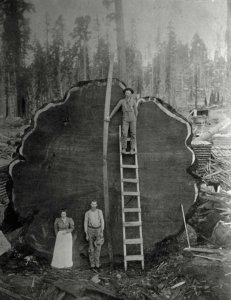
That sequoia is so obviously and remarkably grouped in twos and threes is no doubt owing to the restricted action of this factor as regards area. Thus when an old tree falls, a piece of ground forty or fifty feet in diameter will be cleared by the upturning roots, and a group of seedlings with an even start will speedily take its place. Out of this seedling thicket perhaps two or three may become trees, and then those groups called “Three Graces,” “Faithful Couples,” etc., will be formed. For even supposing they should stand twenty or thirty feet apart while young, by the time they are full grown they will touch and crowd and become “faithful.” Also the branches on the inside of each will die for want of light, and the partial crowns be modelled into one, and the trunks, if close pressed, will appear as a forked specimen derived from one seed, leaning outward toward the top, on account of the outside of each being loaded with branches.
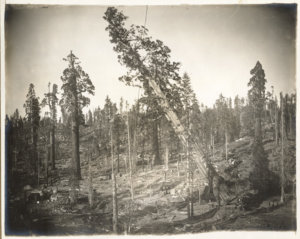
As soon as any mishap befalls the crown of sequoia, such as being stricken off by lightning, or broken by storms, then the branches beneath, no matter how situated, at once become excited, like a colony of bees that have lost their queen, and all seem anxious to repair the damage. Limbs that have grown outward for centuries at right angles to the trunk at once turn upward, and push eagerly on to assist in making a new crown, each speedily assuming the special outline curves of true summits. Even in the case of mere stumps burned half-way, some small ornamental sprout will seem to receive a special call to go aloft and do its best as a leader.
Less than a mile from the southern extremity of this noble forest we enter the so-called “King’s River Grove,” extending southward to the Kaweah divide. Here during a former visit I heard the sound of axes, indicating a group of busy men preparing a section of one of the trees they had felled for exhibition at the Centennial. It was twenty-five feet in diameter at the base, and so fine was the taper, it measured ten feet in diameter at 200 feet from the ground. The age, as counted by three different persons, is from 2125 to 2317, the fineness of the annual wood rings making accuracy in the count rather difficult.
Yet this specimen was by no means a very old-looking tree, and some are undoubtedly much older. A specimen observed by me in the New King’s River Forest is probably over four thousand years old, as it measures thirty-five feet eight inches inside the bark, and is standing upon a dry hill-side where the growth has evidently been slow.
The forests of the south fork of the Kaweah extend up the range to a height of 8400 feet, which is the extreme upper limit of the entire sequoia belt, and here I was so fortunate as to settle definitely the question of the relationship of sequoia to the ancient glaciers, as to the soil they are growing upon. Hooker discovered that the cedars of Lebanon were growing upon an ancient moraine. So also are the giant trees of California. Several years ago, toward the commencement of my glacial studies, I clearly determined the fact that all the upper portion of the general forest belt was not growing upon soil slowly crumbled from the rock by rains and dews and the decomposing atmosphere, but upon moraine soil ground from the mountain flank by the ancient glaciers, and scarce at all modified by post-glacial agents. Pinus contorta, P. flexilis, P. aristata, and P. monticola are planted as regularly in moraine rows and curves as the corn of an Illinois farmer. So also is a considerable portion of the Picea amabilis which forms the upper portion of the main heavy coniferous belt of the Sierra. Next in descending order comes Picea grandis, then Pinus lambertiana, and P. ponderosa, Sequoia gigantea, Libocedrus decurreus, and Abies douglassii, all growing upon moraine soil also, but so greatly modified and obscured by post-glacial weathering as to make its real origin dark or invisible to observers unskilled in glacial phenomena. Here, on the head of the south fork of the Kaweah, the sequoias are established upon moraines of the ancient Kaweah glacier that flowed down the south fork cañon, and scarce more changed thau those occupied by the summit pines.
At the time of my visit this forest was on fire, and as fire, whether occurring naturally by lightning or through the agency of man, is the great master-scourge of forests, and especially of sequoia, I was glad of the opportunity presented to study the methods of its destruction.
Between the river and the west end of the forest there was a heavy growth of cherry, manzanita, and ceanothus, combined into one continuous sheet of chaparral, through which I had to pass on my way into the burning sequoia woods. But this chaparral also was on fire, and the flames were racing up the shaggy hill-side as fast at times as a horse could gallop. Now bending forward and feeding on the green leaves with a passionate roar, devouring acres at a breath, then halting and shooting far into the sky, with flapping edges fringed and hacked like a dandelion leaf.
It was interesting to notice how much faster these wild fires can run up hill than down. If the wind be not among the conditions, then the steeper the better for speed; but when driven by the wind, a certain slope is required for the attainment of the maximum velocity, which slope varies with the wind and the character of the chaparral.
Passing through the smoke and ashes which these wild-fire billows had given for beauty, I pushed up the mountain-side into the burning forest as far as consistent with safety. One is in no danger of being chased and hemmed in by sequoia fires, because they never run fast, the speeding winds flowing only across the tree-tops, leaving the deeps below calm, like the bottom of a sea. Furthermore, there i s no generally distributed fire food in sequoia forests on which fires can move rapidly. Fire can only creep on the dead leaves and burs, because they are solidly packed. Besides the general leaf stratum on which running fires mostly depend for food, there are a good many dead branches that become available here and there. And when aged sequoias fall, their crowns are smashed as if made of glass, making perfect wood-piles, limb piled on limb, broken into lengths of two or three feet, and mingled with the dense leaf tassels. The trunks, also, are broken straight across as if sawed in logs, and when the forest fire comes creeping forward into those grand wood-piles, a most sublime blaze is produced, booming and roaring like a waterfall. But all flame and noise speedily disappear, leaving only the great logs two hundred feet long, and from twenty-five to ten feet thick, lying among the gray ashes like bars of red-hot iron, enveloped in one equal, rich, ruby, flame-less glow. Sequoia fire is more beautiful in color than that of any other species I ever noticed. And now fancy a forest hillside strewn with those majestic trunks straight as arrows, smooth, and perfect in taper and roundness, and covered with a plush of nameless, enthusiastic fire, gorgeous in color as the bars of a sunset cloud. Get this picture clearly before your mind, and you have one of the most perfectly glorious fire spectacles to be found on the face of the earth.
Sequoia smoke is also surpassingly beautiful; not muddy with resiny lamp-black, like that of the pine, but fine brown and purple when well lighted.
Although the fallen trunks burn on the outside for days in succession, they never lose much of their bulk in this way. Strange to say, however, although perfectly undecayed, they burn inside for months, and in so methodical a manner that they are at length bored into regular tubes, as if by some huge auger. For it must be understood that all those far-famed hollow trunks, into which horsemen may gallop, are hollowed, after falling, through the agency of tire. No sequoia is made hollow by decay; and even supposing it possible that in rare instances they should become hollow, like oaks, while yet standing, they would inevitably smash into small fragments when they fell.
Out from beneath the smoke clouds of this suffering forest I made my way across the river and up the opposite slopes into woods not a whit less noble. Brownie the meanwhile had been feeding luxuriously day after day in a ravine, among beds of leersia and wild wheat, gathering strength for new efforts. But way-making became more and more difficult‚—indeed impossible, in common phrase. But just before sundown I reached a charming camp ground, with new sequoias to study and sleep beneath. It was evidently a well-known and favorite resort of bears, which are always wise enough to choose homes in charming woods where they are secure, and have the luxury of cool meadow patches to wallow in, and clover to eat, and plenty of acid ants, wasps, and pine nuts in their season. The bark of many of the trees was furrowred picturesquely by their matchless paws, where they had stood up stretching their limbs like cats. Their tracks were fresh along the stream-side, and I half expected to see them resting beneath the brown trunks, or standing on some prostrate log snuffing and listening to learn the nature of the disturbance. Brownie listened and looked cautiously around, as if doubting whether the place were safe. All mules have the fear of bears before their eyes, and are marvellously acute in detecting them, either by night or day. No dog can scent a bear farther, and as long, therefore, as your mule rests quietly in a bear region, you need have no fears of their approach. But when bears do come into camp, mules tethered by a rope too strong to break are not infrequently killed in trying to run away. Guarding against this danger, I usually tie to an elastic sapling, so as to diminish the shock in case of a stampede, and perhaps thus prevent either neck or rope from breaking.
The starry night circled away in profound calm, and I lay steeped in its weird beauty, notwithstanding the growing danger of being snow-bound, and feeling more than commonly happy; for while climbing the river cañon I had made a fine geological discovery concerning the formation and origin of the quartz sands of the great “dead river” deposits of the northern Sierra.
Two days beyond this bear dell I enjoyed a very charming meeting with a group of deer in one of nature’s most sequestered gardens‚—a spot never, perhaps, neared by human foot.
The garden lies high on the northern cliffs of the south fork. The Kaweah goes foaming past 2000 feet below, while the sequoia forest rises shadowy along the ridge on the north. It is only about half an acre in size, full of golden-rods and eriogonse and tall vase-like tufts of waving grasses with silky panicles, not crowded like a field of grain, but planted wide apart among the flowers, each tuft with plenty of space to manifest its own loveliness both in form and color and wind-waving, while the plantless spots between are covered with dry leaves and burs, making a fine brown ground for both grasses and flowers. The whole is fenced in by a close hedge-like growth of wild cherry, mingled with California lilac and glossy evergreen manzanita, not drawn around in strict lines, but waving in and out in a succession of bays and swelling bosses exquisitely painted with the best Indian summer light, and making a perfect paradise of color. I found a small silver-fir near by, from which I cut plushy boughs for a bed, and spent a delightful night sleeping away all cañon-climbing weariness.
Next morning shortly after sunrise, just as the light was beginning to come streaming through the trees, while I lay leaning on my elbow taking my bread and tea, and looking down across the cañon, tracing the dip of the granite headlands, and trying to plan a way to the river at a point likely to be fordable, suddenly I caught the big bright eyes of a deer gazing at me through the garden hedge. The expressive eyes, the slim black-tipped muzzle, and the large ears were as perfectly visible as if placed there at just the right distance to be seen, like a picture on a wall. She continued to gaze, while I gazed back with equal steadiness, motionless as a rock. In a few minutes she ventured forward a step, exposing her fine arching neck and fore-legs, then snorted and withdrew.
This alone was a fine picture‚—the beautiful eyes framed in colored cherry leaves, the topmost sprays lightly atremble, and just glanced by the level sun rays, all the rest in shadow.
But more anon. Gaining confidence, and evidently piqued by curiosity, the trembling sprays indicated her return, and her head came into view; then another and another step, and she stood wholly exposed inside the garden hedge, gazed eagerly around, and again withdrew, but returned a moment afterward, this time advancing into the middle of the garden; and behind her I noticed a second pair of eyes, not fixed on me, but on her companion in front, as if eagerly questioning, “What in the world do you see?” Then more rustling in the hedge, and another head came slipping past the second, the two heads touching; while the first came within a few steps of me, walking with inimitable grace, expressed in every limb. My picture was being enriched and enlivened every minute; but even this was not all. After another timid little snort, as if testing my good intentions, all three disappeared; but I was true, and my wild beauties emerged once more, one, two, three, four, slipping through the dense hedge without snapping a twig, and all four came forward into the garden, grouping themselves most picturesquely, moving, changing, lifting their smooth polished limbs with charming grace‚—the perfect embodiment of poetic form and motion. I have oftentimes remarked in meeting with deer under various circumstances that curiosity was sufficiently strong to carry them dangerously near hunters; but in this instance they seemed to have satisfied curiosity, and began to feel so much at ease in my company that they all commenced feeding in the garden‚—eating breakfast with me, like gentle sheep around a shepherd‚—while I observed keenly, to learn their gestures and what plants they fed on. They are the daintiest feeders I ever saw, and no wonder the Indians esteem the contents of their stomachs a great delicacy. They seldom eat grass, but chiefly aromatic shrubs. The ceanothus and cherry seemed their favorites. They would cull a single cherry leaf with the utmost delicacy, then one of ceanothus, now and then stalking across the garden to snip off a leaf or two of mint, their sharp muzzle enabling them to cull out the daintiest leaves one at a time. It was delightful to feel how perfectly the most timid wild animals may confide in man. They no longer required that I should remain motionless, taking no alarm when I shifted from one elbow to the other, and even allowed me to rise and stand erect.
It then occurred to me that I might possibly steal up to one of them and catch it, not with any intention of killing it, for that was far indeed from my thoughts. I only wanted to run my hand along its beautiful curving limbs. But no sooner had I made a little advance on this line than, giving a searching look, they seemed to penetrate my conceit, and bounded off with loud shrill snorts, vanishing in the forest.
There is a wild instinctive love of animal-killing in every body, inherited, no doubt, from savage ancestors, and its promptings for the moment have occasionally made me as excitedly blood-thirsty as a wolf. But far higher is the pleasure of meeting one’s fellow-animals in a friendly way without any of the hunter’s gross concomitants of blood and groans.
I have often tried to understand how so many deer, and wild sheep, and bears, and flocks of grouse‚—nature’s cattle and poultry‚—could be allowed to run at large through the mountain gardens without in any way marring their beauty. I was therefore all the more watchful of this feeding flock, and carefully examined the garden after they left, to see what flowers had suffered; but I could not detect the slightest disorder, much less destruction. It seemed rather that, like gardeners, they had been keeping it in order. At least I could not see a crushed flower, nor a single grass stem that was misbent or broken down. Nor among the daisy, gentian, bryanthus gardens of the Alps, where the wild sheep roam at will, have I ever noticed the effects of destructive feeding or trampling. Even the burly shuffling bears beautify the ground on which they walk, picturing it with their awe-inspiring tracks, and also writing poetry on the soft sequoia bark in boldly drawn Gothic hieroglyphics. But, strange to say, man, the crown, the sequoia of nature, brings confusion with all his best gifts, and, with the overabundant, misbegotten animals that he breeds, sweeps away the beauty of wildness like a fire.
Hence into the basin of the Tule the sequoia forests become still more extensive and interesting, and I began to doubt more than ever my ability to trace the belt to its southern boundary before the fall of winter snow. My mule became doubly jaded, and I had to drag him wearily from cañon to cañon, like a fur-trader making tedious portages with his canoe, and to further augment my difficulties, I got out of provisions, while I knew no source of supply nearer than the foot-hills far below the sequoia belt. I began to calculate how long I would be able, or howr long it would be right, to live on manzanita berries, so as to save time that was extremely precious at this critical period of the year, by obviating the necessity of descending to the inhabited foot-hills only to return again.
One afternoon, after eating my last piece of bread, I stood on a commanding ridge overlooking the giant forests stretching interminably to the south, and deliberating whether to push firmly on, depending on what berries I might pick, until I should chance upon some mountaineer’s camp, when a rifle-shot rang out crisp and joyfully over the woods. You may be sure I marked the bearings of that shot in a way not to be forgotten, and steered gladly through the woods in quest of the hunter. I had not gone far ere I struck the track of a shod horse, which I followed to a camp of Indians in charge of a flock of sheep.
The only Indian in camp when I arrived did not seem to understand me very well, but he quickly perceived that I was hungry, and besides, made out to say, in a mixture of words and gestures, that he had a companion who would soon be in who could “heap speak English.”
Toward evening the sheep came streaming dustily in long flies through the woods, and spread out on a meadow near the camp. Then the other Indian came in, to whom I explained my wants. He promised me some flour in the morning, showed me where to tether my mule, and when supper was ready urged me to eat heartily. Sitting around the camp tire, he inquired whether I had been successful in discovering gold in any of the gulches, seeming, like most white men, to be incapable of comprehending any other motive for such explorations; and as a talkative Indian is rarely found, I embraced the opportunity of trying to get some wild knowledge out of him concerning the birds and animals. Unfortunately, however, he made pretensions to civilization, and spoke contemptuously of wild Indians; and of course the peculiar instincts of wildness belonging to his race had become dim; neither did he seem to have any special knowledge of mountain life, not even of bears; and as for wild sheep, he never had seen them. He informed me, however, that the ” big trees” still extended far south, he knew not how far, but that he had seen them in crossing the range from Visalia to Lone Pine. His only item of information likely to prove available was that a saw-mill was located somewhere on the south fork of the Tule, where I would find provisions.
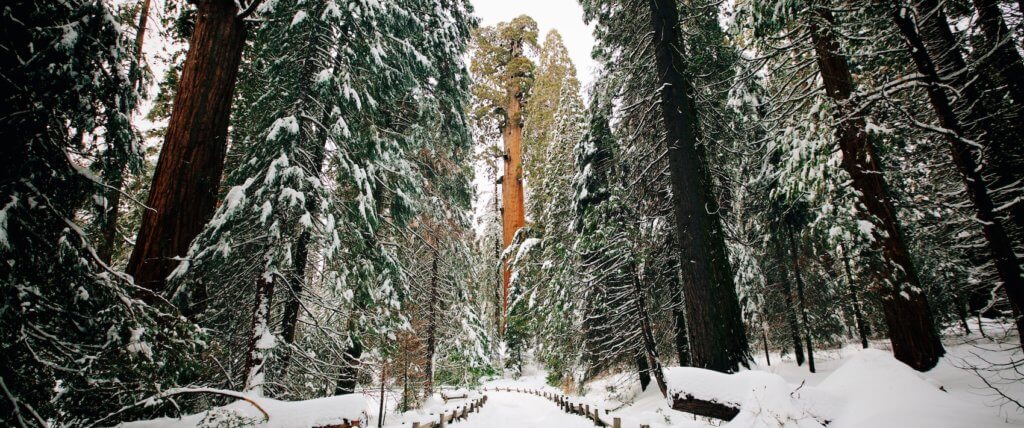
Next morning, after receiving a few pounds of flour and a strip of dried mutton, I plunged again into the wilderness.
The entire upper portion of the Tule basin is magnificently forested with sequoia, the finest portion being on the north fork. This, indeed, is, I think, the noblest block of sequoia in the entire belt, surpassing even the giant forest of the Kaweah. Southward from here I thought I could detect a slight falling off in the density and general thrift of the forest, without, however, noticing any further indication of approach to the southern limit. It is a remarkable and significant fact that, upon the whole, the species becomes more and more fully the master tree of the forest belt the farther south, until within a few miles of its limit. Here it is the first tree one meets forming heavy forests, either in ascending or descending I the range. Only a fringe of small or sparsely planted pines and firs occurs above it, and a like scanty fringe beneath. But although the area occupied by the species increases in so significant a degree toward the south, there is no corresponding increase in the size of individual trees. The height and girth of the largest of the old groves are, with a few marked exceptions, about equal to any I have seen in the new forests. General Grant, of the King’s River Grove, has acquired considerable notoriety in California as “the biggest tree in the world,” though in reality less interesting and not so large as many others of no name. The diameter of forty feet claimed for it is obtained by measuring close down on the ground around its wide-spreading craggy base. A fair measurement makes it about equal to the Mariposa giant (thirty feet diameter), which it also resembles in general appearance.
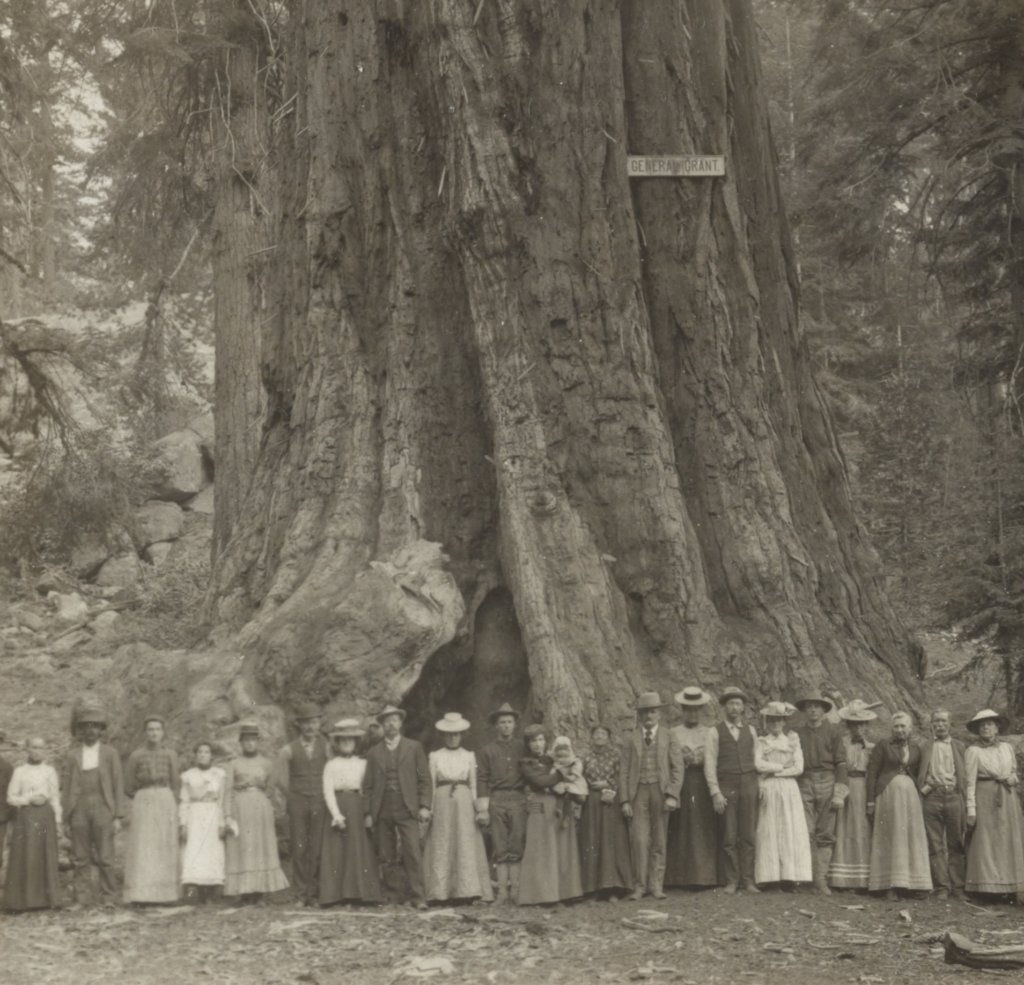
In pushing across the Tule basin I encountered terribly precipitous cañons. Even the small tributaries run in deep gorges, exceedingly difficult to get down into, and still more difficult to climb out of with a mule. I thought of abandoning saddle and blankets and turning him free, and thus turn myself free; for no mountaineer is truly free who is trammelled with friend or servant, or who has the care of more than two legs. Besides, it seems cruel to make any animal share one’s toil without being capable of sharing its rewards. What cared Brownie for botany beyond grasses, or for landscapes beyond glacier meadows?
Large flocks of sheep had swept the South Tule Basin bare of grass, and of course Brownie had hard fare. After turning him loose one night to pick what little the place afforded, I busied myself building a fire, paying no attention to him, when, after prospecting the lean ground, and finding nothing but bushes to browse on, he returned to camp, stole close up to me, almost thrusting his nose against my face, and, in the solemn stillness of the gloaming, poured forth a most lamentable compound of bray and neigh, and with all its horrid blare pervaded by pathetic, supplicatory tones of hunger. The horror of so grim a vision of weariness and want I shall not attempt to tell. I hastily offered him half my little remnant of bread, made from the last of the flour given me by the Indians, and though unleavened and charred by baking on the coals, he devoured it greedily. Next morning I pushed directly down the mountains to the inhabited foot-hills, and turned him loose in a corral to botanize at will among abundance of alfalfa and barley; then procured a fresh animal from a friendly mountaineer, and climbed back to the sequoias to complete my work, or at least to remain in the woods until winter set in.
The ridge between the South Tule and Deer Creek is well planted with sequoia; but the trees are decidedly shorter and less irrepressible in aspect, and I began to feel confident that the southern limit of the species could not be very far distant. I was greatly interested here to find that the species had crossed over into the upper valley of the Kern, and planted colonies northward along the eastern slope of the western summit, or Greenhorn range. The western summit, like a branch axis, puts out from the main backbone of the Sierra at the head of King’s River, trending southward, and inclosing the upper valley of the Kern on the west; and it is just where this lofty spur begins to break down on its approach to its southern termination that sequoia has been able to cross it.
Pushing on still southward over the divide between the north and south forks of Deer Creek, I found that the southern boundary was at length crossed, and a careful scrutiny of the woods beyond failed to discover a single sequoia, or any trace of its former existence; and now all that remained was to descend the range, and make a level way home along the plain.
It appears, then, from this general survey of the sequoia forest, that, notwithstanding the colossal dimensions of the trees, and their peculiarly interesting character, more than ninety per cent, of the whole number of individuals belonging to the species have hitherto remained unknown to science.
We are now ready for the question, Was the species ever more extensively distributed on the Sierra in post-glacial times?
We have been led to the conclusion that it never was, because, after careful search along the margins of the groves and forests and in the gaps between, we have not observed indications of any kind whatsoever of its previous existence beyond its present bounds; notwithstanding I feel confident that if every sequoia in the range were to die to-day, numerous monuments of their existence would remain of so imperishable a nature as to be available for the student more than ten thousand years hence.
In the first place, we might notice that no species of coniferous tree in the range keeps its individuals so well together as sequoia. A mile is, perhaps, about the greatest distance of any straggler from the main body, and all of those stragglers that have come under my observation are young, instead of old monumental trees, relics of a more extended growth.
Again, we might recall in this connection the well-known longevity of individual trees; and the fact that the trunks frequently endure for centuries after they fall. I have a specimen block cut from a fallen trunk which is in no way distinguishable from specimens taken from living trees, notwithstanding the old trunk fragment from which it was derived has lain on the damp ground for more than 380 years. The measure of time in the case is simply this: when the ponderous trunk to which the old vestige belonged fell, it sunk itself into the ground, thus making a long straight ditch, and in the middle of this ditch a silver-fir is growing that is now four feet in diameter, and 380 years old, as determined by cutting it half through and counting the rings, thus demonstrating that the remnant of the trunk that made the ditch has lain on the ground more than 380 years. For it is evident that, to find the whole time, we must add to the 380 years the time that the vanished portion of the trunk lay in its ditch before being burned out of the way, plus the time that passed ere the seed from which the monumental fir sprang fell into the prepared soil and took root. Now, because sequoia trunks are never wholly consumed in one forest fire, and these fires recur only at considerable intervals, and because sequoia ditches after being cleared are often left implanted for centuries, then it becomes evident that the trunk remnant in question may probably have lain a thousand years or more; and this instance is by no means a rare one.
But admitting that upon those areas supposed to have been once covered with sequoia every tree may have fallen, and every trunk been burned or buried, leaving not a single remnant, many of the long straight ditches made by the fall of the trunks, and the deep wide bowls made by their upturning roots, would remain patent for thousands of years after the last remnant of the trunks that made them had disappeared. Much of this sequoia ditch-writing would no doubt be speedily effaced by the flood action of overflowing streams and rain-washing; but no inconsiderable portion would be enduringly engraved on ridge-tops beyond all such destructive action. And where all the conditions are favorable, sequoia ditch-writing is almost absolutely imperishable, as might easily be rigidly demonstrated had we sufficient space, and readers of sufficient patience. But in the mean time I only wish to fix attention on the fact that these historic ditches and root bowls occur in all the present groves and forests of sequoia, but not the faintest vestige of one outside of them has yet presented itself. We therefore conclude that the area covered by sequoia has not been diminished during the last eight or ten thousand years, and probably not at all in postglacial times.
The climatic changes in progress in the Sierra, bearing upon the tenure of forest life, are wholly misapprehended, especially as to the time and means employed by nature in effecting them. It is constantly asserted, in a vague way, that the Sierra climate was vastly wetter than now, and that the increasing drought will of itself extinguish sequoia in a short time, leaving the ground to firs and pines supposed to be capable of growing upon drier soil. But that sequoia can and does grow on as dry soil as that occupied by either fir or pine is manifest in a thousand places along the main belt. “Why, then,” it will be asked, “are sequoias always found in greatest abundance on well-watered places where small perennial streams abound?” Simply because a close growth of sequoia always produces those streams. The thirsty mountaineer knows wrell that in every sequoia grove he will find running water, but it is a very complete mistake to suppose that the water is the cause of the grove being there; for, on the contrary, the grove is the cause of the water being there. Drain off the water, and the grove will remain. But cut off the grove, and the streams and springs will at once disappear.
When attention is called to the method of sequoia stream-making, it will be apprehended at once.
The roots of this immense tree cover the ground, forming a thick dense sponge that absorbs and holds back the rains and melting snows, yet allowing them to ooze and flow gently. Indeed, every fallen leaf and rootlet, as well as long clasping root and prostrate trunk, is a dam, hoarding the bounty of storm clouds, and dispensing it in blessings all through the summer, instead of allowing it to go headlong in short-lived floods. Evaporation is also checked by the densely foliaged sequoia to a greater extent than by any other mountain tree. Thick masses of air that are soon saturated are entangled among the massive crowns, or drift slowly like icebergs around clustering islets, while thirsty winds are prevented from sponging and licking along the ground.
So great is the retention of water in many portions of the main belt that bogs and meadows are created; by the killing and consequent falling of the trees a single trunk falling across a stream often forms a dam 200 feet long and ten to thirty feet high, giving rise to a pond which, kills the trees within its reach; these dead trees fall in turn, thus clearing the ground; while sediments gradually accumulate, changing the pond into a bog or drier meadow for a growth of carices and sphagnum. In some instances a chain of small bogs rise above one another on a hill-side, which are gradually merged into one another, forming sloping bogs and meadows.
Since, then, it is a fact that thousands of sequoias are growing thriftily on what is termed dry soil, and even clinging like mountain pines to rifts on granite precipices, and since it has been shown that the extra moisture found in connection with the denser growths is an effect of their presence instead of a cause of their presence, then the prevailing notions as to the previous extension of the species and its near approach to extinction, based upon its supposed dependence on greater moisture, are seen to have in this connection no real significance.
The decrease of the rain-fall since the close of the glacial epoch in the Sierra is not nearly so great as is generally guessed. The highest post-glacial water-marks are well preserved on all the upper river channels, and they are not greatly higher than the spring flood-marks of the present, showing conclusively that no extraordinary decrease has taken place in the volume of post-glacial Sierra streams since they came into existence.
Credit
Printed in Harpers https://scholarlycommons.pacific.edu/jmb/7/
Harper’s, New Monthly Magazine, v. 57, no. 342, Nov., 1878
https://harpers.org/sponsor/natpark/the-new-sequoia-forests-of-california
Mark Twain Photo by Curtis, C. C. (Charles Clifford), 1891. https://lccn.loc.gov/2019630606 Library of Congress Control Number 2019630606
Stereoscopic Photo of General Grant labeled,” The “General Grant,” the largest tree in the world. Gen’l Grant Nat. Park, Fresno, California. R.Y. Young 1902. Library of Congress #2017659883. https://www.loc.gov/item/2017659883/
Grant Grove Winter Photo by Brian A Petersen.
Citation
Muir, John, “The New Sequoia Forests of California.” (1878). John Muir: A Reading Bibliography by Kimes. 7.
https://scholarlycommons.pacific.edu/jmb/7


